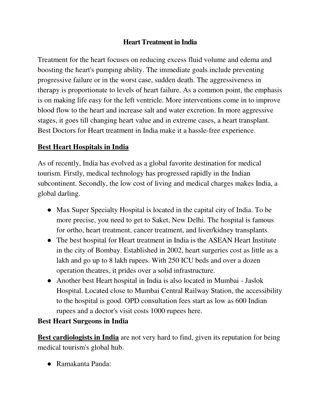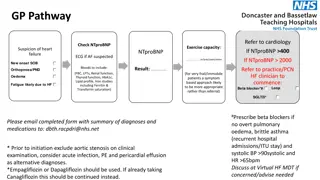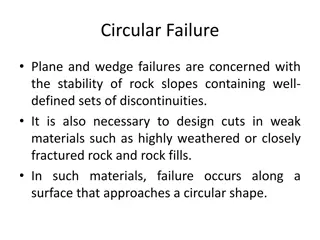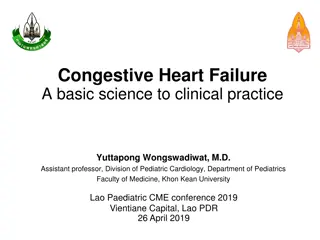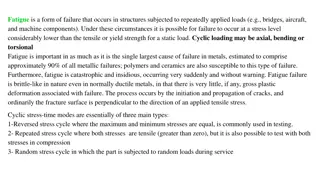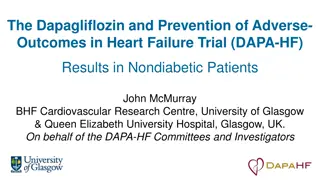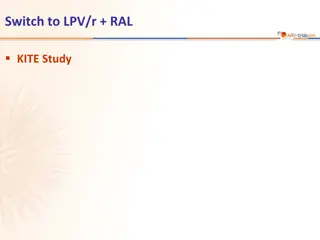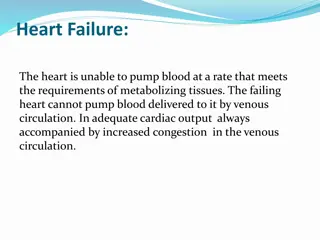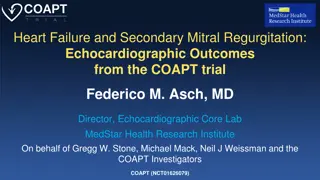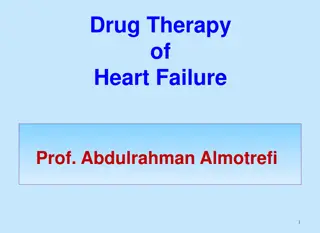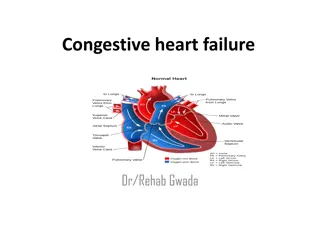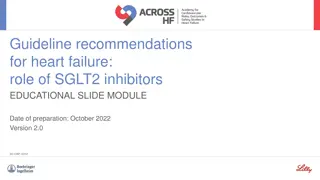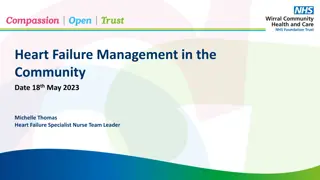Comprehensive Heart Failure Case Presentation: Diagnosis and Treatment Plan
A 68-year-old man with a history of CAD and diabetes presents with symptoms of heart failure, including dyspnea and fluid retention. His medical history, physical exam, and diagnostic tests reveal signs consistent with heart failure. Further evaluation and treatment planning are necessary to manage his condition effectively.
Download Presentation

Please find below an Image/Link to download the presentation.
The content on the website is provided AS IS for your information and personal use only. It may not be sold, licensed, or shared on other websites without obtaining consent from the author. Download presentation by click this link. If you encounter any issues during the download, it is possible that the publisher has removed the file from their server.
E N D
Presentation Transcript
Heart failure case presentation Assist. Lec. Sura abbas Medicine ward
Key points: The most common causes of heart failure are coronary artery disease (CAD), cardiomyopathy. hypertension, and dilated The angiotensin aldosterone system (RAAS) involved in disease progression. sympathetic nervous system and the renin- Symptoms of left-sided heart failure include dyspnea, orthopnea, and paroxysmal nocturnal dyspnea (PND), whereas symptoms of right-sided heart failure include fluid retention, GI bloating, and fatigue.
Chief complaints A 68-year-old man with a history of known CAD and type 2 diabetes mellitus presents for a belated follow-up clinic visit (his last visit was 2 years ago). His most bothersome complaint is SOB at night when lying down flat; he has to sleep on three pillows to get adequate rest and sometimes even that does not help. Although he used to be able to walk a few blocks and two to three flights of stairs comfortably before getting breathless, he has had increasing symptoms after one flight of stairs. He also notes his ankles are always swollen and his shoes no longer fit; therefore he only wears slippers. Additionally, he has difficulty finishing his meals due to bloating and nausea, and overall his appetite is decreased. What information is suggestive of a diagnosis of HF? What additional information do you need to know before creating a treatment plan?
Medical History, Physical Examination, and Diagnostic Tests PMH: Dyslipidemia 20 years, type 2 diabetes mellitus 15 years, coronary artery disease 10 years (MIs in 1999 and 2002), history of alcohol abuse 30 years, FH: Significant for early heart disease in mother (MI at age 63) SH: He is disabled from a previous accident; he is married, has three children, and runs his own business; he drinks 10 to 12 beers nightly history of migraines 40 years Allergies: No known drug allergies Meds: Diltiazem CD 240 mg once daily, nitroglycerin 0.4 mg sublingual as needed (last use yesterday after showering), glipizide 10 mg twice daily for diabetes, metformin 1000 mg twice daily atorvastatin 40 mg once daily for dyslipidemia, naproxen 220 mg twice daily as needed vitamin B12 once daily, multivitamin daily, aspirin 81 mg once daily for diabetes, for headaches,
Physical examination BP 126/84 mm Hg, pulse 60 beats/min and regular, respiratory rate 16/min, Ht 5 8 (173 cm), Wt 251 lb (114 kg), body mass index (BMI): 38.2 kg/m2 Lungs are auscultation prolonged phase CV: Regular rhythm with normal S1 and S2; S3 and a soft S4 present Abd: Soft, nontender, and bowel sounds are present, (+) hepatojugular reflux Ext: 2+ pitting edema extending to below the knees is observed. JVP 11 cm Chest x-ray: Bilateral pleural effusions and cardiomegaly Echocardiogram: EF = 25% (0.25) clear with expiratory to a rate and there is an
Laboratory Values Hct: 41.1% (0.411) WBC: 5.3 103/ L (5.3 109/L) Sodium: 136 mEq/L (136 mmol/L) Potassium: 3.2 mEq/L (3.2 mmol/L) Bicarb: 30 mEq/L (30 mmol/L) Chloride: 90 mEq/L (90 mmol/L) Magnesium: 1.5 mEq/L (0.75 mmol/L) Fasting blood glucose: 120 mg/dL (6.7 mmol/L) Uric acid: 8 mg/dL (476 mol/L) BUN: 40 mg/dL (14.3 mmol/L) SCr: 1.6 mg/dL (141 mol/L) Alk Phos: 120 IU/L (2.00 Kat/L) Aspartate aminotransferase: 100 IU/L (1.67 Kat/L)
questions What other laboratory or diagnostic tests are required for assessment of the patient s condition? How would you classify his NYHA FC and ACC/AHA HF stage? Identify exacerbating or precipitating factors that may worsen his HF. What are your treatment goals for the patient?
Desired Therapeutic Outcomes There is no cure for HF. The general therapeutic management goals for chronic HF include: preventing the onset of clinical symptoms or reducing symptoms by which one? preventing or reducing hospitalizations, slowing progression of the disease, improving quality of life, and prolonging survival. ? How?
Non pharmacologic treatment involves dietary modifications such as sodium and fluid restriction, risk factor reduction including smoking cessation, timely immunizations, and supervised regular physical activity. Patient education (monitoring symptoms, dietary and medication adherence, exercise and physical fitness) Home monitoring should include daily assessment of weight and exercise tolerance.
Pharmacological options Diuretics Type of diuretics? Route of intake? Diuretic resistance? How to tx it? Diuretics se?
Pharmacological options to reduce hospitalization: ACE.I (choice, se, monitoring, CI) ARABS BB ( carvedilol, bisoprolol, metoprolol succinate or tartrate) Aldosterone antagonist Hydralazine/ isosorbide dinitrate Note: there are compensatory mechanisms in HF to increase CO, it will be helpful in the beginning but by passing time it will lead to worsening the condition which include( RAAS, SNS, cardiac hypertrophy and remodeling)
Other drugs: CCB Amlodipine, felodipine Sacubitril( home work role in hf) Digoxin ( added if pt remain symptomatic or in AF)(DOSE) Antiplatelet and anticoagulant Warfarin if AF or prosthetic heart valve
Acute heart failure (ADHF) Acute heart failure syndromes (AHFS) may be defined as new-onset, gradual, or rapidly worsening chronic HF signs and symptoms that require urgent therapy.
Acute heart failure (ADHF) After 6 months, the patient returns to the clinic complaining of extreme SOB with any activity, as well as at rest. He sleeps sitting up due to severe orthopnea, can only eat a few bites of a meal and then feels full and nauseous, and states he has gained 22 lb (10 kg) from his baseline weight. He is also profoundly dizzy when standing up from a chair and bending over. He states that he does not feel his furosemide therapy is working. He is admitted to the cardiology unit. SH: Admits to resuming previous alcohol intake; additionally, he has been eating out in restaurants more often in the past 2 weeks Meds: Atorvastatin 40 mg once daily, lisinopril 10 mg once daily, furosemide 80 mg twice daily, glipizide 10 mg twice daily for diabetes, metformin 1000 mg twice daily for diabetes, nitroglycerin 0.4 mg sublingual as needed, multivitamin daily, aspirin 325 mg daily
Physical examination VS: BP 96/54 mm Hg, pulse 102 beats/min and regular, respiratory rate 22/minute, temperature 37 C (98.6 F), Wt 273 lb (124 kg), BMI 41.5 kg/m2 Lungs: There are rales present bilaterally CV: Regular rate and rhythm with normal S1 and S2; there is an S3 and an S4; a 4/6 systolic ejection murmur is present
jugular veins are distended, JVP is 11 cm above sternal angle Abd: Hard, tender, and bowel sounds are present; 3+ pitting edema of extremities is observed CXR: Bilateral pleural effusions and cardiomegaly Echo: EF = 20% (0.20) Pertinent labs: BNP 740 pg/mL (740 ng/L; 214 pmol/L),?
Lab data K: 4.2 mEq/L (4.2 mmol/L), BUN 64 mg/dL (22.8 mmol/L), SCr 2.4 mg/dL (212 mol/L), Mg 1.8 mEq/L (0.9 mmol/L); A pulmonary catheter is placed, revealing the following: PCWP 37 mm Hg (4.9 kPa); CI 2.5 L/min/m2 What NYHA functional class, ACC/AHA stage, and hemodynamic subset is the patient currently in? What are your initial treatment goals? What pharmacologic agents are appropriate to use at this time? Identify a monitoring plan to assess for efficacy and toxicity of the recommended drug therapy. Once symptoms are improved, how would you optimize oral medication therapy for this patient s HF
Treatment of acute heart failure and Desired Therapeutic Outcomes correct the underlying precipitating factor(s); (cardiac, metabolic or patient related) relieve the patient s symptoms and improve hemodynamics. optimize a chronic oral medication regimen and educate the patient, reinforcing adherence to lifestyle modifications and the drug regimen (dose and SE). Oral agents: -blockers, ACE inhibitors or ARBs, and aldosterone antagonists should be initiated as soon as possible during the hospitalization(contribute to improvement in hemodynamics).
Pharmacologic Approaches to Treatment of AHF Diuretics Loop diuretics, including furosemide, bumetanide, and torsemide (DOC) Diuretics decrease preload by functional venodilation within 5 to 15 minutes of administration and subsequently by an increase in sodium and water excretion. This provides rapid improvement in symptoms of pulmonary congestion. Route Bolus injection should be administered at a rate not exceeding 4 mg per minute to avoid ototoxicity
Vasodilators IV vasodilators cause a rapid decrease in arterial tone (After load), resulting in a decrease in SVR and a subsequent increase in SV and CO. Additionally, vasodilators reduce ventricular filling pressures (PCWP) (preload) within 24 to 48 hours, reduce myocardial oxygen consumption, and decrease ventricular workload. Nitroglycerin, nitroprusside, and nesiritide
Inotropic agents This class include dopamine, dobutamine and milrinone Used in patients with decreased CO( COOL SUBSETS) dopamine, dobutamine need beta receptors to act while milrinone is not
Reference: Pharmacotherapy principle and practice 2016






